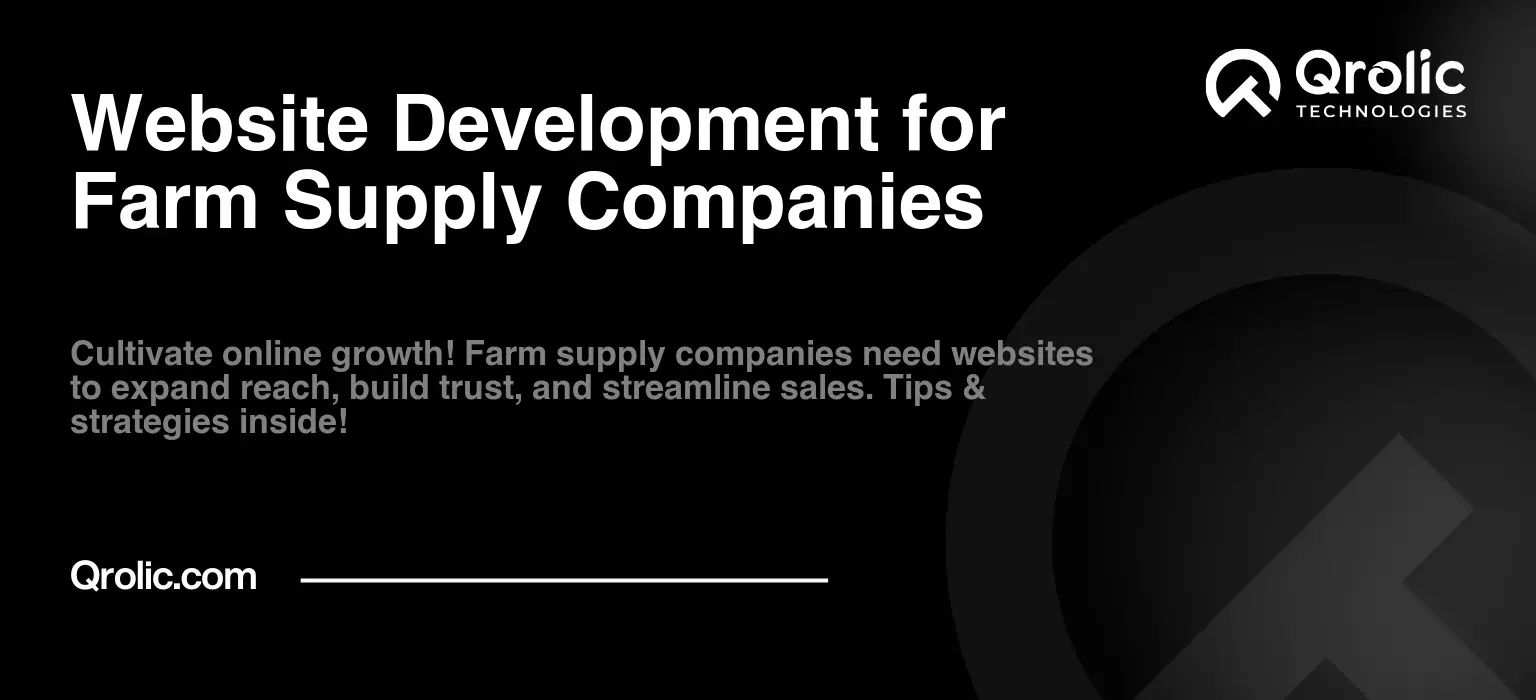The modern farm supply company needs more than just a physical storefront; it needs a robust online presence. In today’s digital age, farmers are increasingly turning to the internet to research products, compare prices, and even make purchases. A well-developed website is no longer a luxury but a necessity for farm supply businesses looking to thrive. This comprehensive guide explores the multifaceted world of farm supply website development, offering practical strategies, actionable tips, and expert insights to help you cultivate growth online.
Quick Summary:
- A modern website grows your farm supply business.
- Ensure easy navigation, great products, and mobile access.
- Use SEO and marketing to attract more farmers.
- Secure e-commerce boosts sales and streamlines operations.
Table of Contents
- I. Why Invest in Farm Supply Website Development? Sowing the Seeds of Success
- A. Expanding Your Reach Beyond Geographical Boundaries: Harvesting a Wider Market
- B. Building Brand Authority and Trust: Cultivating Customer Confidence
- C. Providing 24/7 Accessibility and Convenience: Watering the Seeds of Customer Satisfaction
- D. Streamlining Sales and Operations: Harvesting Efficiency and Productivity
- E. Gathering Valuable Customer Data and Insights: Tilling the Soil for Targeted Marketing
- II. Key Elements of a Successful Farm Supply Website: Planting the Seeds of a User-Friendly Experience
- A. User-Friendly Navigation and Site Structure: Guiding Customers Through Your Online Orchard
- B. High-Quality Product Information and Images: Showcasing Your Harvest
- C. Mobile-Responsive Design: Adapting to the Changing Landscape
- D. Secure E-Commerce Functionality: Harvesting Online Sales
- E. Engaging Content and Resources: Nourishing Customer Knowledge
- F. Clear Call-to-Actions: Guiding Customers to the Checkout
- G. Customer Support and Contact Information: Cultivating Relationships
- III. SEO Strategies for Farm Supply Websites: Growing Your Online Visibility
- A. Keyword Research: Planting the Right Seeds for Search Success
- B. On-Page Optimization: Nurturing Your Website’s Search Engine Appeal
- C. Content Marketing: Irrigating Your Website with Fresh, Relevant Information
- D. Link Building: Grafting Your Website with Authoritative Connections
- E. Local SEO: Cultivating Your Community’s Online Presence
- IV. E-Commerce Considerations for Farm Supply Websites: Harvesting Online Profits
- A. Choosing the Right E-Commerce Platform: Selecting the Right Tool for the Job
- B. Managing Inventory and Fulfillment: Streamlining Your Operations
- C. Providing Secure Payment Options: Ensuring Customer Trust
- D. Implementing Shipping and Delivery Strategies: Reaching Customers Reliably
- E. Providing Excellent Customer Service: Cultivating Customer Loyalty
- V. Marketing Strategies for Farm Supply Websites: Spreading the Word About Your Online Orchard
- A. Search Engine Marketing (SEM): Sowing Paid Seeds for Instant Visibility
- B. Social Media Marketing (SMM): Cultivating a Community of Engaged Farmers
- C. Email Marketing: Nurturing Leads and Building Relationships
- D. Content Marketing: Cultivating Trust and Authority
- E. Public Relations (PR): Harvesting Positive Media Coverage
- VI. Measuring Success: Tracking Your Website’s Performance
- A. Website Traffic: Monitoring Visitor Flow
- B. Conversion Rate: Measuring Sales Effectiveness
- C. Bounce Rate: Identifying Areas for Improvement
- D. Average Order Value: Maximizing Revenue Per Customer
- E. Customer Lifetime Value (CLTV): Cultivating Long-Term Relationships
- VII. The Future of Farm Supply Websites: Adapting to the Changing Agricultural Landscape
- A. Increased Personalization: Tailoring the Online Experience
- B. Enhanced Mobile Experience: Catering to On-the-Go Farmers
- C. Integration of Emerging Technologies: Leveraging Innovation
- D. Focus on Sustainability: Appealing to Environmentally Conscious Farmers
- E. Data-Driven Decision Making: Optimizing for Results
- VIII. Qrolic Technologies: Your Partner in Cultivating Online Growth
- IX. Conclusion: Harvesting Success with a Strategic Online Presence
I. Why Invest in Farm Supply Website Development? Sowing the Seeds of Success
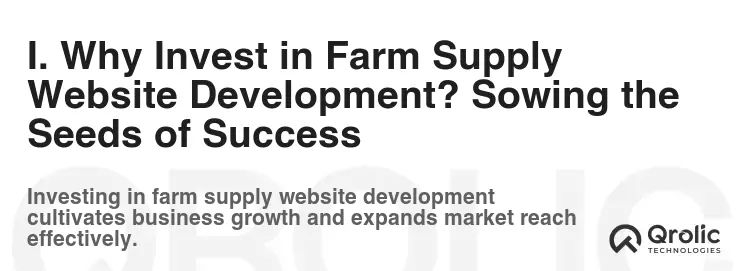
Having a strong online presence isn’t just about keeping up with the times; it’s about actively shaping the future of your farm supply business. Here are some compelling reasons to invest in agricultural web design and development:
A. Expanding Your Reach Beyond Geographical Boundaries: Harvesting a Wider Market
Traditionally, farm supply companies are limited by their physical location. A website tears down those walls, allowing you to reach farmers across a wider geographical area – even nationally or internationally. This expanded reach translates directly into increased sales opportunities and revenue potential.
- Example: A farm supply company in Iowa could use a targeted online marketing campaign to reach farmers in Nebraska or Illinois, expanding its customer base beyond its immediate vicinity.
B. Building Brand Authority and Trust: Cultivating Customer Confidence
A professional and informative website instantly boosts your credibility and builds trust with potential customers. By showcasing your expertise, product knowledge, and commitment to customer service, you can establish yourself as a reliable and trustworthy partner for farmers.
- How: Regularly publishing valuable content, such as blog posts, articles, and videos, demonstrates your expertise and establishes you as a thought leader in the industry. Featuring customer testimonials and case studies further solidifies your reputation.
C. Providing 24/7 Accessibility and Convenience: Watering the Seeds of Customer Satisfaction
Farmers operate around the clock, often working long hours in the fields. A website provides them with 24/7 access to your products, information, and services, allowing them to browse, research, and even make purchases at their convenience.
- Benefit: This accessibility eliminates the need for phone calls during busy seasons and allows farmers to make informed decisions on their own time.
D. Streamlining Sales and Operations: Harvesting Efficiency and Productivity
An e-commerce enabled website can streamline your sales process, automate order management, and reduce administrative overhead. This increased efficiency allows your team to focus on other critical tasks, such as customer service and product innovation.
- Example: An online ordering system can automatically generate invoices, track inventory, and notify customers of shipment updates, freeing up your staff to handle more complex customer inquiries.
E. Gathering Valuable Customer Data and Insights: Tilling the Soil for Targeted Marketing
A website provides a wealth of data about your customers’ behavior, preferences, and buying habits. By analyzing this data, you can gain valuable insights into your target market and tailor your marketing efforts accordingly.
- Strategies: Using website analytics tools to track page views, bounce rates, and conversion rates can help you identify areas for improvement and optimize your website for better performance.
II. Key Elements of a Successful Farm Supply Website: Planting the Seeds of a User-Friendly Experience
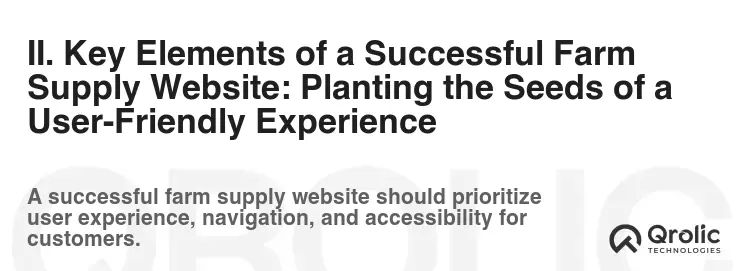
A well-designed agribusiness website design is more than just a pretty face; it’s a strategic tool that can drive sales, build brand awareness, and enhance customer satisfaction. Here are the essential elements that every farm supply website should include:
A. User-Friendly Navigation and Site Structure: Guiding Customers Through Your Online Orchard
A clear and intuitive navigation system is crucial for ensuring that visitors can easily find the information they need. Use a logical site structure with well-defined categories and subcategories to guide users through your website.
- Best Practices: Use a simple and consistent menu structure, implement a search function, and provide breadcrumb navigation to help users understand their location within the site.
B. High-Quality Product Information and Images: Showcasing Your Harvest
Your product pages should provide detailed information about each item, including specifications, features, benefits, and pricing. Use high-quality images and videos to showcase your products in their best light.
- Tips: Include multiple images from different angles, provide zoom functionality, and offer downloadable product manuals and spec sheets.
C. Mobile-Responsive Design: Adapting to the Changing Landscape
With the increasing use of smartphones and tablets, it’s essential to have a mobile-responsive website that adapts seamlessly to different screen sizes and devices.
- Why: A mobile-friendly website provides a better user experience for mobile users and can improve your search engine ranking.
D. Secure E-Commerce Functionality: Harvesting Online Sales
If you plan to sell products online, you’ll need a secure e-commerce platform that can handle transactions safely and efficiently. Choose a platform that integrates with popular payment gateways and provides robust security features to protect customer data.
- Features: Shopping cart, secure checkout process, multiple payment options, order tracking, and customer account management.
E. Engaging Content and Resources: Nourishing Customer Knowledge
Provide valuable content that educates, informs, and engages your target audience. This could include blog posts, articles, videos, infographics, and downloadable resources.
- Content Ideas: Crop management tips, livestock care guides, pest control strategies, industry news, and product demonstrations.
F. Clear Call-to-Actions: Guiding Customers to the Checkout
Use clear and concise call-to-actions (CTAs) to guide visitors towards desired actions, such as requesting a quote, placing an order, or contacting customer service.
- Examples: “Shop Now,” “Get a Free Quote,” “Contact Us,” “Download Our Catalog,” “Learn More.”
G. Customer Support and Contact Information: Cultivating Relationships
Make it easy for customers to contact you with questions or concerns. Provide clear contact information, including phone number, email address, and physical address (if applicable). Consider adding a live chat feature for instant support.
- Options: Contact form, FAQ page, knowledge base, live chat, and social media support.
III. SEO Strategies for Farm Supply Websites: Growing Your Online Visibility
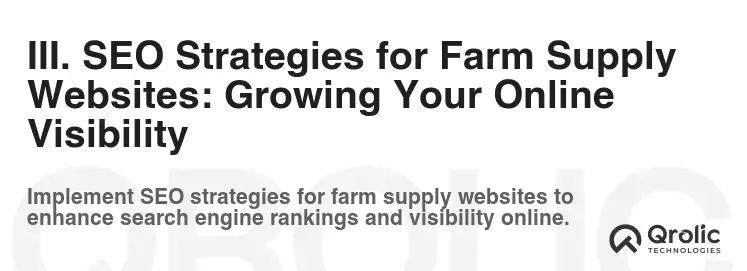
Search engine optimization (SEO) is crucial for driving organic traffic to your website and improving your search engine ranking. Here are some effective SEO strategies for farm supply website development:
A. Keyword Research: Planting the Right Seeds for Search Success
Identify the keywords and phrases that your target audience is using to search for farm supplies online. Use keyword research tools to find relevant keywords with high search volume and low competition.
- Examples: “farm supplies,” “agricultural equipment,” “fertilizers,” “pesticides,” “seeds,” “livestock feed.”
B. On-Page Optimization: Nurturing Your Website’s Search Engine Appeal
Optimize your website’s content, meta descriptions, and title tags with relevant keywords to improve your search engine ranking. Ensure that your website is well-structured, easy to navigate, and mobile-friendly.
- Elements: Title tags, meta descriptions, header tags (H1, H2, H3), image alt text, URL structure, and internal linking.
C. Content Marketing: Irrigating Your Website with Fresh, Relevant Information
Create high-quality, informative, and engaging content that appeals to your target audience and incorporates relevant keywords. Publish blog posts, articles, videos, and infographics on topics related to farm supplies and agriculture.
- Strategy: Regularly update your website with fresh content to keep it relevant and engaging for both users and search engines.
D. Link Building: Grafting Your Website with Authoritative Connections
Build high-quality backlinks from other reputable websites in the agriculture industry. This can help improve your website’s authority and search engine ranking.
- Techniques: Guest blogging, directory submissions, broken link building, and outreach to influencers in the agricultural sector.
E. Local SEO: Cultivating Your Community’s Online Presence
Optimize your website for local search by including your business name, address, and phone number (NAP) on every page. Claim your business listing on Google My Business and other online directories.
- Benefits: Helps farmers in your local area find your business more easily in online searches.
IV. E-Commerce Considerations for Farm Supply Websites: Harvesting Online Profits
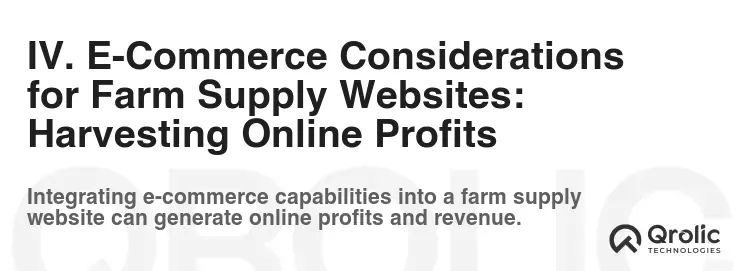
If you plan to sell products online, you’ll need to carefully consider your e-commerce strategy. Here are some key considerations for building a successful online farm supply store:
A. Choosing the Right E-Commerce Platform: Selecting the Right Tool for the Job
Select an e-commerce platform that meets your specific needs and requirements. Consider factors such as scalability, security, payment gateway integration, and ease of use.
- Popular Platforms: Shopify, WooCommerce, Magento, BigCommerce.
B. Managing Inventory and Fulfillment: Streamlining Your Operations
Implement a robust inventory management system to track stock levels, manage orders, and prevent overselling. Choose a fulfillment strategy that is efficient, cost-effective, and reliable.
- Options: In-house fulfillment, third-party logistics (3PL), drop shipping.
C. Providing Secure Payment Options: Ensuring Customer Trust
Offer a variety of secure payment options to cater to different customer preferences. Choose a payment gateway that is PCI compliant and provides robust fraud protection.
- Options: Credit cards, debit cards, PayPal, Apple Pay, Google Pay, ACH transfers.
D. Implementing Shipping and Delivery Strategies: Reaching Customers Reliably
Develop a clear and transparent shipping policy that outlines shipping costs, delivery times, and return procedures. Offer multiple shipping options to cater to different customer needs.
- Strategies: Flat-rate shipping, free shipping over a certain order value, expedited shipping, local delivery.
E. Providing Excellent Customer Service: Cultivating Customer Loyalty
Provide prompt, helpful, and friendly customer service to address any questions or concerns. Offer a variety of support channels, such as phone, email, and live chat.
- Key: Building strong customer relationships is essential for long-term success in the competitive farm supply market.
V. Marketing Strategies for Farm Supply Websites: Spreading the Word About Your Online Orchard
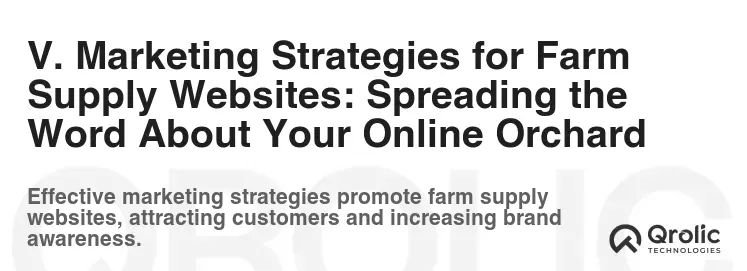
Once your website is up and running, you’ll need to implement a marketing strategy to drive traffic and generate sales. Here are some effective marketing strategies for agricultural web design and agribusiness website design:
A. Search Engine Marketing (SEM): Sowing Paid Seeds for Instant Visibility
Use paid advertising platforms, such as Google Ads, to target potential customers who are searching for farm supplies online.
- Benefits: Allows you to reach a large audience quickly and effectively, and provides detailed tracking and reporting.
B. Social Media Marketing (SMM): Cultivating a Community of Engaged Farmers
Engage with your target audience on social media platforms such as Facebook, Twitter, and LinkedIn. Share valuable content, run contests, and participate in industry discussions.
- Tips: Create engaging content that resonates with your audience, use relevant hashtags, and respond to comments and messages promptly.
C. Email Marketing: Nurturing Leads and Building Relationships
Build an email list and send regular newsletters, promotional offers, and product updates to your subscribers.
- Strategies: Segment your email list to target specific customer groups, personalize your emails, and track your results to optimize your campaigns.
D. Content Marketing: Cultivating Trust and Authority
Create valuable content that educates, informs, and engages your target audience. This could include blog posts, articles, videos, infographics, and downloadable resources.
- Key: Regularly update your website with fresh content to keep it relevant and engaging for both users and search engines.
E. Public Relations (PR): Harvesting Positive Media Coverage
Reach out to industry publications, bloggers, and influencers to secure media coverage and build brand awareness.
- Tactics: Press releases, media kits, influencer outreach.
VI. Measuring Success: Tracking Your Website’s Performance
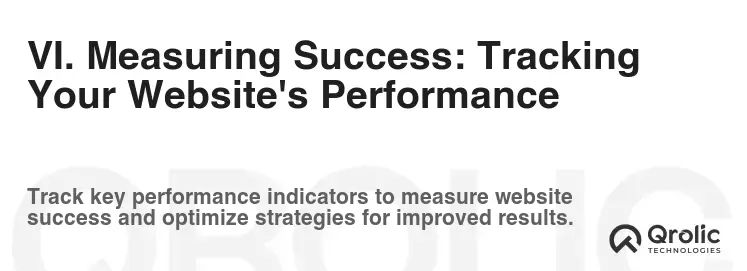
It’s essential to track your website’s performance to determine whether your efforts are paying off. Here are some key metrics to monitor:
A. Website Traffic: Monitoring Visitor Flow
Track the number of visitors to your website, as well as their source (e.g., organic search, paid advertising, social media).
- Tools: Google Analytics.
B. Conversion Rate: Measuring Sales Effectiveness
Track the percentage of visitors who complete a desired action, such as making a purchase or filling out a contact form.
- Significance: Provides insights into the effectiveness of your website’s design and content.
C. Bounce Rate: Identifying Areas for Improvement
Track the percentage of visitors who leave your website after viewing only one page.
- Interpretation: High bounce rates may indicate that your website is not relevant to visitors’ search queries or that your website is difficult to navigate.
D. Average Order Value: Maximizing Revenue Per Customer
Track the average amount of money that customers spend per order.
- Strategies: Upselling and cross-selling can help increase average order value.
E. Customer Lifetime Value (CLTV): Cultivating Long-Term Relationships
Track the total revenue that a customer is expected to generate over the course of their relationship with your business.
- Importance: Understanding CLTV can help you prioritize customer acquisition and retention efforts.
VII. The Future of Farm Supply Websites: Adapting to the Changing Agricultural Landscape

The future of farm supply websites is likely to be shaped by several key trends, including:
A. Increased Personalization: Tailoring the Online Experience
Websites will become increasingly personalized, using data to tailor the user experience to individual customer needs and preferences.
B. Enhanced Mobile Experience: Catering to On-the-Go Farmers
Mobile devices will continue to play a dominant role in online activity, so websites will need to provide a seamless and intuitive mobile experience.
C. Integration of Emerging Technologies: Leveraging Innovation
Emerging technologies, such as artificial intelligence (AI) and augmented reality (AR), will be integrated into farm supply websites to enhance the customer experience.
D. Focus on Sustainability: Appealing to Environmentally Conscious Farmers
Websites will increasingly highlight sustainable products and practices to appeal to environmentally conscious farmers.
E. Data-Driven Decision Making: Optimizing for Results
Website owners will rely more heavily on data analytics to make informed decisions about website design, content, and marketing.
VIII. Qrolic Technologies: Your Partner in Cultivating Online Growth

Qrolic Technologies (https://qrolic.com/) is a leading provider of website development and digital marketing services for farm supply companies. We understand the unique challenges and opportunities of the agricultural industry and can help you build a website that drives sales, builds brand awareness, and enhances customer satisfaction.
-
Services Offered: Website design and development, e-commerce solutions, SEO, SEM, social media marketing, content marketing, and email marketing.
-
Why Choose Qrolic Technologies: Experienced team, industry expertise, proven track record, customized solutions, and affordable pricing.
Ready to cultivate your online presence? Contact Qrolic Technologies today for a free consultation.
IX. Conclusion: Harvesting Success with a Strategic Online Presence
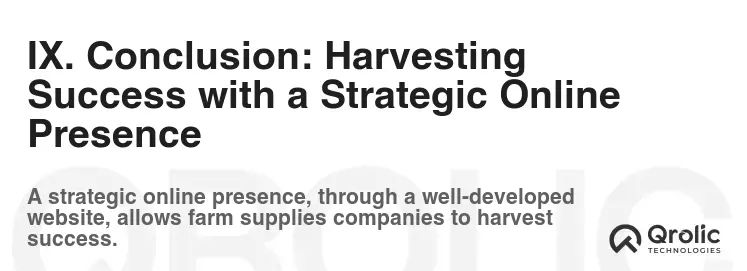
In conclusion, website development for farm supply companies is a critical investment for businesses looking to thrive in today’s digital age. By creating a user-friendly, informative, and engaging website, you can expand your reach, build brand authority, streamline sales, and gather valuable customer data. By implementing effective SEO and marketing strategies, you can drive traffic to your website and generate sales. And by staying ahead of the curve with emerging technologies and industry trends, you can ensure that your website remains a valuable asset for years to come. With the right strategy and the right partner, you can cultivate a thriving online presence and harvest success in the competitive farm supply market.
